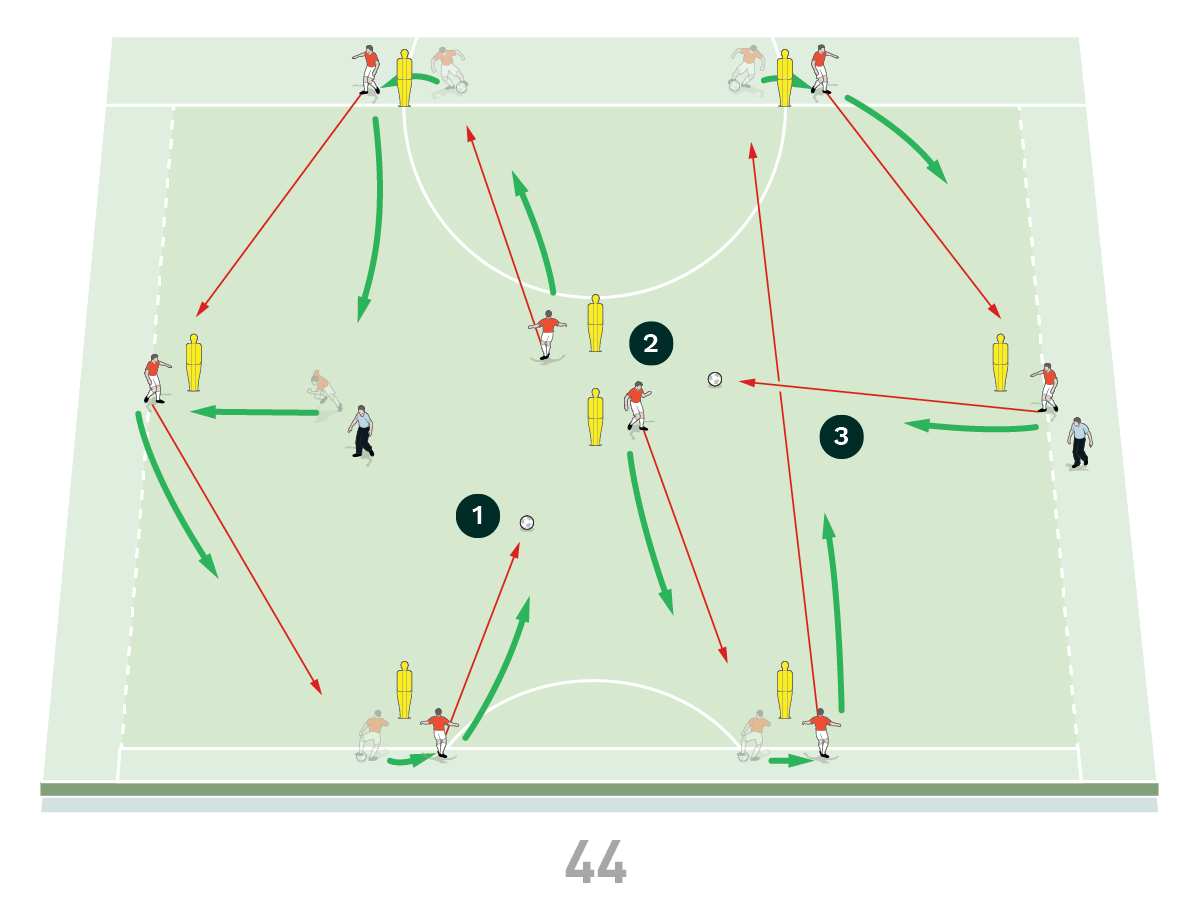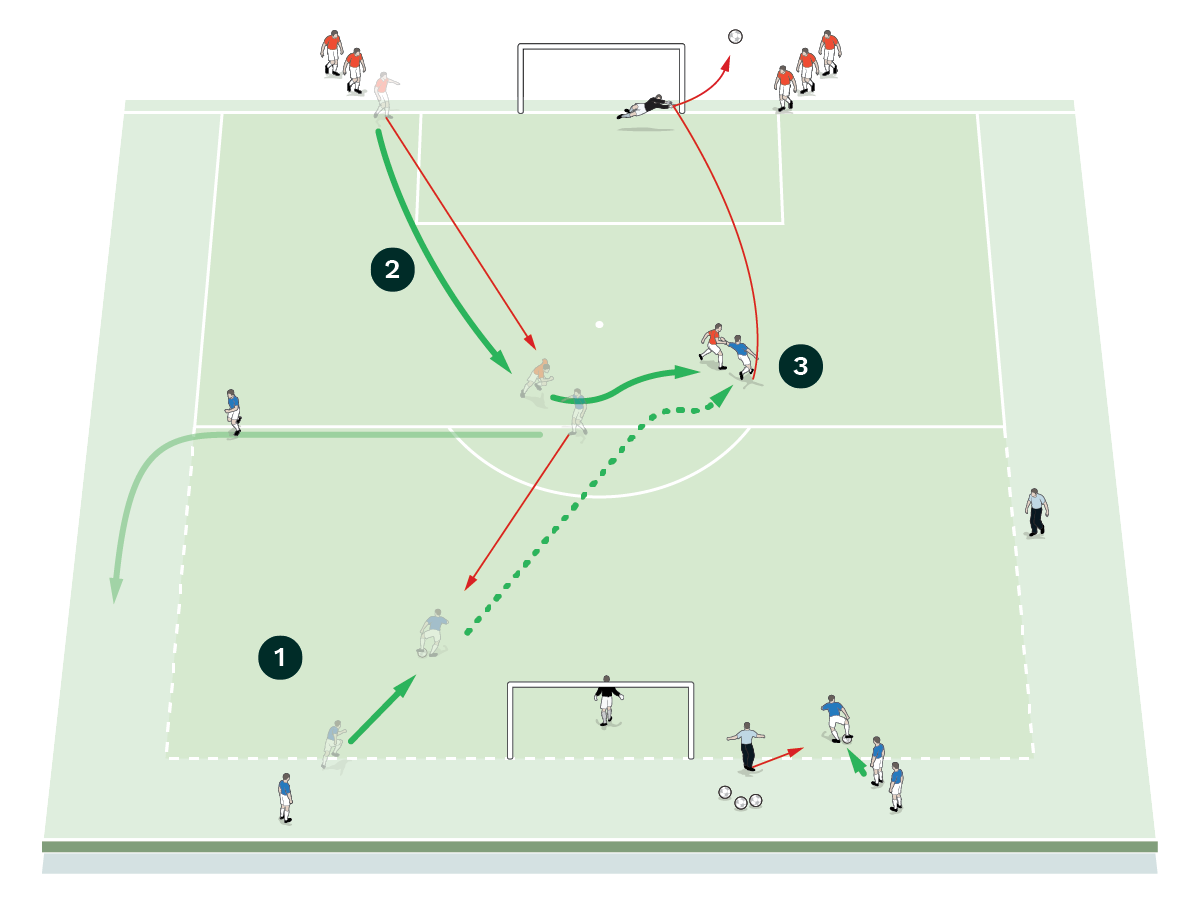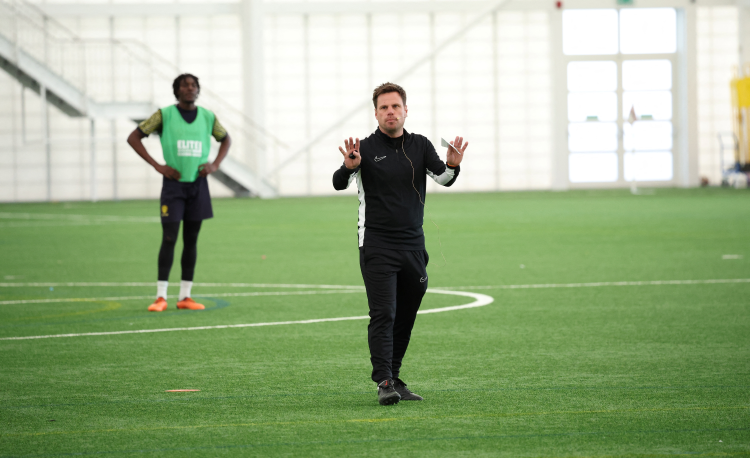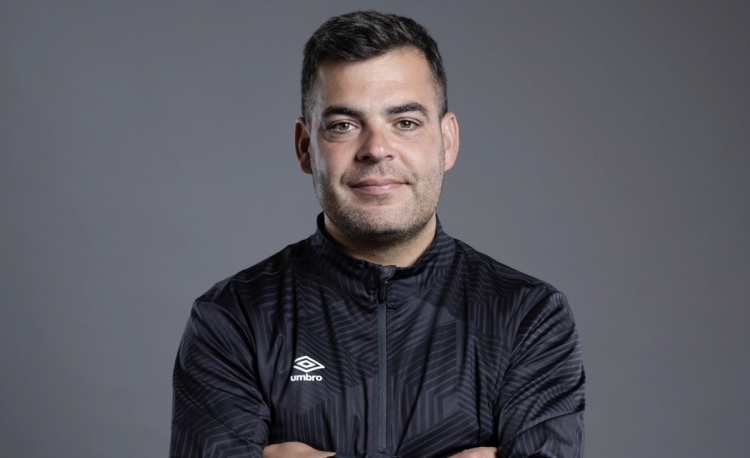Developing a determination and resilient mindset towards 1v1 duels
The session is about an individual’s ability to show determination and resilience when defending 1v1.

| Area | Full size pitch |
| Equipment | Balls, bibs, 2 full size goals, cones |
| No. of Players | 18 outfield + 2 goalkeepers |
| Session Time |
Passing drill: 12mins |
The session is about an individual’s ability to show determination and resilience when defending 1v1. We will trade-off some tactical elements within the session but with an understanding of what we want to achieve, in terms of the development of technical, psychological and physical attributes.
Ultimately, I think we would all agree the game is made up of many individual duels all over the pitch. Most important is the psychological strength and intelligence needed to win your battle; how are you going to outthink, outsmart and outrun your opponent? The practices are designed to see who will run and do the hard yards when it gets tough, who will show grit and determination to run back and defend for the team and who will make the hard forward runs to create space for themselves or others. Another important outcome from the session is an insight into the character and personality of the players you work with.
The practice progresses from individual 1v1 duels to 3v3 then into 6v6 or more, depending on the size of the group. As the practice develops it starts to focus on the important technical and psychological details first, individually within a 1v1 situation and then how your role develops when defending 3v3, 6v6, etc. We continue to progress the session by adding mini goals, then big goals. We then start to look more tactically at how to apply pressure, cover and balance within a small-sided practice or game.
We would typically work on a 1v1 focus at least once a week, with a variety of constraints depending on what is needed physically from the day. It may be working in tight areas with less output but more physical contact. It may be across a bigger area encouraging the ability to make runs into space to receive the ball, or to create space for others with a big psychological focus on the determination to not be beat 1v1.
Pass and pull
An area the width of the penalty box, and lengthwise from the edge of the box to the halfway line is set up. Ten outfield players are used with eight mannequins – two at either edge of the centre-circle and on the 18-yard line, with two more situated in the centre, and one each towards the edge of the pitch. Two coaches are positioned in defensive positions. Two balls will be in play as the players run a passing pattern, with the balls starting with the two central players. Once a pass is played, the players will follow their pass [1].
[1]

-
Two balls are in play as the players run a passing pattern
- The balls start with the two middle players
- Players follow their pass
Consider four three-minute rounds for this exercise, with the focus on pulling to clear passing lines and receiving to play forward, depending on where the defender positions themselves.
1v1: press, shot, defend the goal
The next exercise requires an 18x18-yard square, with two full size goals at either end. 12 outfield players are used plus two goalkeepers, in two teams of six.
Reds are the defending team to start, with blues the attacking team. A red defender plays a ball to a blue striker, who starts in the middle of the square. The striker will look to get a shot off immediately as the defender closes them down quickly. The coach will then play the ball into another attacker from the side of the pitch to go 1v1 against the defender [2a].
[2a]

-
Reds are the defending team to start, the blues are the attacking team
- A defender plays a ball to a striker who starts in the middle
- The striker gets a shot off immediately as the defender closes them down quickly
- The coach then plays the ball into another attacker to go 1v1 against the defender
The play resets with the reds defender playing the ball into the blues striker [2b].
[2b]

-
Play then resets
- A defender plays the ball into the striker
- If the striker feels they can’t get their shot off they can pass the ball to another attacker for a 1v1 battle
If the striker feels they can’t get their shot off, they can pass the ball to another attacker for a 1v1 battle.
Again, we look to do four three-minute rounds, and it will also be worth practicing alternates to the other side. A progression can be to use the striker as a bounce player in the 1v1 practice.
Mourinho 3v3
We use three 15x15-yard squares with six mini goals placed as shown. Twelve outfield players will be split into two teams of six; this time the exercise will be three six-minute rounds.
The game will start with a 3v3 in the first square. A coach plays the ball into the blue team who attack the goals and score. Both teams then move to the square at the other end, where another coach plays a ball into a blue player [3a].
[3a]

-
A coach plays the ball in to the blue team who attack the goals and score
- Both teams move to the square at the other end, where another coach plays a ball into a blue player
The blue team must now work the ball into the centre square [3b].
[3b]

-
The blue team must work the ball into the centre square
- Both teams are now attacking the inverted goals
- The blues work the ball to score
- The reds press to win it back
Both teams are now attacking the inverted goals. The blues will be expected to work the ball to score, while the reds will press to win it back. This will encourage forward runs and transition as well as receiving with pressure from behind.
The trade-off to this practice is that you may lose tactical positioning/realism, but the gains to it are more psychological, technical and physical aspects.
Man for man +1
Half a pitch will be used in length, with the width of the 18-yard box used across. There will be a full size goal at each end and 18 players used, including two goalkeepers. Eight outfield players from each team are matched up with a player from the other team – players can only tackle their partner. Each team has one free – or floating – player who can only intercept the ball. In this instance, the reds use their floating player to create an attack, with the ball crossed in from the right and a goal scored [4a].
[4a]

-
Nine outfield players from each team are matched up with a player from the other team – players can only tackle their partner
- Each team has one free, or floating, player who can intercept the ball
- The reds use their floating player to create an attack and score a goal
Once a goal is scored, play will resume from the opposite goal. The defending blue player whose attacking red partner has scored must run around the opposite goal from where the goal has been scored and then get back onto the pitch. The goalscorer cannot score again until their opposite partner is back on the pitch [4b].
[4b]

-
Once a goal has been scored, play resumes from the opposite goal
- The defending player matched with the goalkeeper must run around the goal and get back onto the pitch
- The goalscorer cannot score again until their partner is back on the pitch
This will apply throughout. Other pairs are also encouraged to intercept heavy touches – but not tackle. The exercise focuses on tracking runners and running past players in behind, to create goalscoring opportunities.
Demonstrating grit and determination not to be beaten 1v1 is important, as are the technical aspects we focused on earlier in the session and the endurance to keep making movements and runs. Are they able to outthink, outsmart and outrun their opponent?
COACHING POINTS
What are the key things to look for?
Technique out of possession – so body positioning, distances, balance, anticipation and agility.
In possession – spatial recognition, faints and double movements, balance and intelligence.
Tactically out of possession – pressure, balance and cover, utilising 2v1s with the goalkeeper when defending 1v1s around the goal, showing away from goal and blocking the back post.
In possession – spotting runs, opposite movements, making forward runs, recognising strengths in other 1v1 duels within your team.
What are the typical mistakes players might make and how do I avoid them?
Typically, some of the mistakes you may see within 1v1 drills is the body positioning of the defender who needs to try and avoid getting too upright and square. You may see impatience and players diving in unnecessarily, as well as picking the wrong time to try and win the ball, potentially giving away free-kicks and penalties.
Editor's Picks
Attacking transitions
Deep runs in the final third
Using the goalkeeper in build-up play
Intensive boxes drill with goals
Penetrating the final third
Creating and finishing
My philosophy
Pressing initiation
Compact team movement
Coaches' Testimonials
Related
Coaches' Testimonials
Join the world's leading coaches and managers and discover for yourself one of the best kept secrets in coaching. No other training tool on the planet is written or read by the calibre of names you’ll find in Elite Soccer.
In a recent survey 92% of subscribers said Elite Soccer makes them more confident, 89% said it makes them a more effective coach and 91% said it makes them more inspired.
Get Monthly Inspiration
All the latest techniques and approaches
Since 2010 Elite Soccer has given subscribers exclusive insight into the training ground practices of the world’s best coaches. Published in partnership with the League Managers Association we have unparalleled access to the leading lights in the English leagues, as well as a host of international managers.
Elite Soccer exclusively features sessions written by the coaches themselves. There are no observed sessions and no sessions “in the style of”, just first-hand advice delivered direct to you from the coach.






















